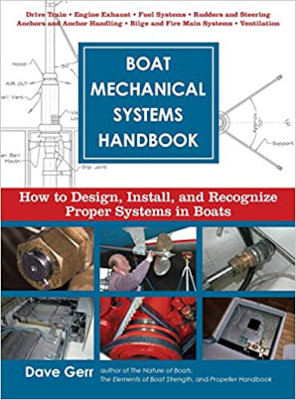 It is a genuine pleasure to read just about anything Dave Gerr writes. His books range from popular broad-appeal works like The Nature of Boats to very specialized books like the Propeller Handbook and The Elements of Boat Strength. On this specialization scale, Boat Mechanical Systems falls somewhere in the middle.
It is a genuine pleasure to read just about anything Dave Gerr writes. His books range from popular broad-appeal works like The Nature of Boats to very specialized books like the Propeller Handbook and The Elements of Boat Strength. On this specialization scale, Boat Mechanical Systems falls somewhere in the middle.
In this book, the focus is on systems and the subtitle is accurate and descriptive: “How to design, Install, and Recognize Proper Systems in Boats.” For the surveyor and general reader, “recognize proper systems in boats” is the critical phrase.
Many will use this book as a reference. Often it will be consulted when there is already a problem with a particular system. Dave has anticipated this by including sections for analyzing common problems. Owners who are planning refits and upgrades to their basic systems will find the book to be an excellent starting point for planning purposes.
The book covers the fundamental mechanical systems that are common to all power and sailboats. It does not cover sailboat rigging, electrical systems, or electronics. The sail rig in not common to all boats and the electrical and electronic systems are not … well, mechanical.
Dave’s contention is that each of these groups of systems is sufficiently complex to deserve its own book. Engines are not covered, as such, but the book does cover their fuel and exhaust systems and their power trains. The systems are divided into sections: drivetrain, fuel, exhaust, rudders and steering, ventilation (including heating and air-conditioning), plumbing, and anchoring.
There are many formulas and calculations with examples so the reader can see whether components are properly sized and can properly choose new components in an upgrade or refit. Because the book is intended to be a reference book, it focuses on the mainstream systems seen in custom and production boats today. Even so, Dave can’t resist the temptation to take the reader into the dark corners where some interesting and unusual gear resides. In the section on drivetrains, we are shown the fundamentals of constructing a retracting dory propeller (I had always wondered how to do that). In chapter 13, the reader is treated to a lot of unusual ways to steer a boat, all of which have been tried and were to some degree successful. (You forgot the canoe J-stroke, Dave.) This collection of odd bits of trivia is typical Dave Gerr. He can’t help himself. While this stuff adds spice to the work, it fits nicely amid the mainstream methods and devices and, in some way, puts the ordinary stuff in perspective.
The book is illustrated with many photographs and line drawings. The line drawings are particularly nice; the book designer used them for decoration as well as illustration — a nice effect. There are many tables, calculations, and conversions in the appendices and a very strong bibliography.
Dave Gerr started as a naval architect with MacLear and Harris in 1979 and opened his own office in 1983 in New York City. He is currently the director of the Westlawn Institute of Marine Technology, which has produced more notable yacht designers than any other source; in fact, perhaps more than all other sources combined.
This book was written by the headmaster of the best school. It probably belongs in your library if you are curious about how good mechanical systems should be designed and built.
Boat Mechanical Systems Handbook: How to Design, Install, and Recognize Proper Systems in Boats by Dave Gerr (International Marine, 2009)




